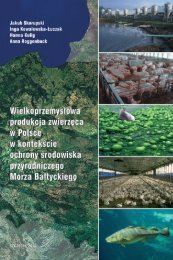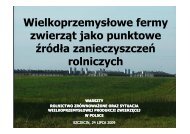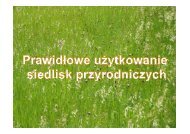best available technologies for manure treatment - Baltic Green Belt
best available technologies for manure treatment - Baltic Green Belt
best available technologies for manure treatment - Baltic Green Belt
Create successful ePaper yourself
Turn your PDF publications into a flip-book with our unique Google optimized e-Paper software.
Best Available Technologies <strong>for</strong> <strong>manure</strong> <strong>treatment</strong> baltic sea 2020<br />
ANNEX J: KEY ELEMENTS OF POLISH LEGISLATION IN RELATION TO N AND P LEACHING<br />
ANNEX J: KEY ELEMENTS OF POLISH LEGISLATION IN<br />
RELATION TO N AND P LEACHING<br />
The Water Law – article 47 of this regulation states<br />
the overall rule that all agriculture activities should<br />
prevent N chemical compounds discharges into<br />
water. Moreover it states that Directors of Regional<br />
Water Management Authority will specify ground<br />
water and surface water susceptible to N chemical<br />
compounds from agricultural sources and areas<br />
particularly vulnerable from which runoff of N from<br />
agriculture sources to the waters ought to be limited.<br />
Regulation of Minister of Environment on criteria of<br />
outlining water susceptible to N discharges from agriculture<br />
– this regulation sets the criteria describing<br />
water which should be classified as water polluted<br />
with nitrates and water in danger of being polluted<br />
with nitrates. It also describes thresholds above which<br />
eutrophication process starts in water.<br />
Regulation of Minister of Environment on specific<br />
requirements to be met by action programs aiming to<br />
mitigate N runoff from agriculture – this regulation<br />
describes actions and procedures which prevent N<br />
runoff from agriculture into water.<br />
Implementation of the Nitrate Directive: Poland has<br />
assigned 21 areas, ca 5% of the Polish agricultural<br />
land, as particularly vulnerable to nitrates from agricultural<br />
sources. The outflow of N from these areas to<br />
water should be reduced. These areas (N Vulnerable<br />
Zones, VNZ) have been legally empowered by 11<br />
regulations of Regional Water Management Board directors<br />
(published in the Official Journals of specific<br />
regions).<br />
Polish Inspection <strong>for</strong> Environmental Protection (IEP)<br />
monitors farms operating in NVZ, including these<br />
which do not fall under IPPC regime.<br />
The Polish act on fertilisers and fertilizing transposes<br />
the Resolution of the European Parliament and the<br />
council No 2003/2002 of 13.10.2003 on fertilisation<br />
into polish law. It set certain obligations which<br />
should be fulfilled by farmers when using <strong>manure</strong>:<br />
• The dose of <strong>manure</strong> applied during the year may<br />
not contain more than 170 kg N (N) pure component<br />
per 1 ha of agricultural land (Article 17. 3),<br />
• IPPC pig farm with more than 2 000 places <strong>for</strong><br />
productive pigs with weight more than 30 kg or<br />
750 places <strong>for</strong> sows is obliged to:<br />
- Make a plan of fertilization, comprising<br />
regulations in legal acts and “Good Agriculture<br />
Practise” (below).<br />
- Make use of at least 70% of <strong>manure</strong> on<br />
the farm arable land and the rest of 30%<br />
can be sold, on bases of written agreement<br />
that a purchaser has to prepare fertilisation<br />
plan in 30 days. (Article 18.1).<br />
- Manure and slurry are stored only in<br />
sealed containers enabling the collection<br />
of at least 4-monthly production of fertiliser.<br />
These tanks should be closed tanks<br />
(Article 25.1),<br />
- Fertilisers other than <strong>manure</strong> and slurry<br />
must be stored on the impervious plates<br />
which are secured in such way that leaks<br />
are not released into soil (Article 25.2).<br />
• The Polish Inspection <strong>for</strong> Environmental<br />
Protection prepares in<strong>for</strong>mation on requirements<br />
<strong>for</strong> IPPC farms to achieve an integrated permit.<br />
The regional chemical-agricultural stations<br />
conduct controlling activities, including nutrient<br />
<strong>treatment</strong>, on these installations each year.<br />
The act on fertilisers and fertilization prohibits<br />
the use of (most important prohibitions):<br />
• fertilisers on soils flooded with water and covered<br />
with snow or frozen <strong>for</strong> depth of 30 cm and<br />
during rainfall (Article 20.1.1),<br />
• <strong>manure</strong> in a liquid <strong>for</strong>m on soils without plant<br />
cover located on slopes above 10% and the<br />
vegetation intended <strong>for</strong> direct human consumption<br />
(Article 20.1.2a),<br />
94








